
Insurers across Australia are increasingly being called to respond to the rising impact of catastrophic events – from widespread flooding and devastating bushfires to severe storms and cyclones. These events are not only becoming more frequent, but also more intense and unpredictable.
We covered how insurers can start to rebuild trust after natural disasters in a recent blog — you can read the five steps we recommend here.
To keep pace with this new reality, insurers need to build greater agility and resilience into their operations. Below, we explore three key priorities to help them do just that.
Operational Preparedness and Scalability
In the face of large-scale disasters, operational resilience is critical. Insurers need business continuity plans that account for staff displacement, system outages, and rapid increases in call and claim volumes. Cloud-based platforms can help maintain service continuity, while partnerships with third-party assessors and builders enable faster response times. Conducting regular catastrophe simulations–particularly for high-risk regions–can reveal bottlenecks and ensure teams are ready to scale operations when it matters most.
Claims Process Agility
Natural disasters create emotional and financial stress for affected communities. Insurance organisations must ensure claims processes are fast, simple, and empathetic. Streamlining First Notification of Loss (FNOL) through digital channels, enabling photo or drone-based damage assessments, and providing real-time claim updates all reduce delays and frustration. Additionally, having surge capacity plans in place–both human and technological–can prevent service breakdowns during peak demand.
Proactive and Personalised Communication
When disaster strikes, policyholders look to their insurer not just for coverage, but for clear and timely guidance. Whether it’s alerting customers in flood-prone regions, providing safety tips ahead of bushfire season, or explaining next steps after a storm, communication must be proactive, relevant and easy to access. Multichannel strategies that span SMS, email, and call centres are essential.
Necessarily, messaging should be tailored by policy type, location, and customer need. Enabling two-way digital interactions is equally important, allowing customers to report changes or ask questions in real time.
With climate volatility now a permanent part of the risk landscape, Australian insurers must continue evolving – not just in how they assess and price risk, but in how they prepare, respond and communicate.
Those who prioritise preparedness, agility, and customer connection will be best positioned to navigate the next major event while supporting their communities through it.
Attributable to Eileen Potter, VP, Insurance, Smart Communications.


Comments
Remove Comment
Are you sure you want to delete your comment?
This cannot be undone.